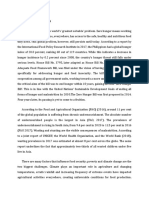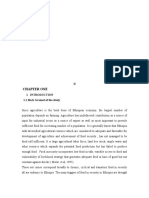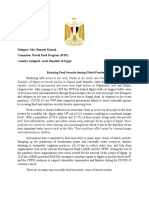Improving Access To Family Planning Can Promote Food Security in The Face of Ethiopia's Changing Climate
Improving Access To Family Planning Can Promote Food Security in The Face of Ethiopia's Changing Climate
Uploaded by
FuturesGroup1Copyright:
Available Formats
Improving Access To Family Planning Can Promote Food Security in The Face of Ethiopia's Changing Climate
Improving Access To Family Planning Can Promote Food Security in The Face of Ethiopia's Changing Climate
Uploaded by
FuturesGroup1Original Title
Copyright
Available Formats
Share this document
Did you find this document useful?
Is this content inappropriate?
Copyright:
Available Formats
Improving Access To Family Planning Can Promote Food Security in The Face of Ethiopia's Changing Climate
Improving Access To Family Planning Can Promote Food Security in The Face of Ethiopia's Changing Climate
Uploaded by
FuturesGroup1Copyright:
Available Formats
Improving Access to Family Planning Can Promote Food Security in the Face of Ethiopias Changing Climate
Study Summary: Modeling Food Security, Population Growth and Climate Change
March 2012
Climate change is expected to reduce agricultural yields in Ethiopia Already, 60% of Ethiopians have insufficient food consumption Almost 30% of children under five years of age are underweight Continued rapid population growth will add to the challenge of food insecurity
Photo by Oxfam
Evaluation PRH
Climate change is resulting in rising temperatures and shifts in rainfall patterns that are expected to decrease agricultural productivity in Ethiopia. Currently, many parts of the country are facing acute food insecurity. Rapid population growth will add to this challenge. Ensuring sufficient food for Ethiopias growing population will require new strategies to boost agricultural yields, and to sustain progress in improving access to nutritious foods for Ethiopias poorest and most affected populations. New research demonstrates that slower population growth, achievable by addressing womens needs for family planning, can also play a significant role in adapting to climate change and promoting future food security in Ethiopia.1
A recent assessment indicates that much of Ethiopia today is facing serious food insecurity (see Figure 1). In general, food consumption is lower among the poor, those with smaller agricultural plots, and those living in large families. The average daily per capita calorie requirement needed to maintain the health of the population in Ethiopia is approximately 2,200. Currently, 60% of the population consumes fewer calories than this daily physiological requirement.2 The average daily per capita calorie consumption is about 1,980 a shortfall of about 220 calories per day, on average, compared with internationally recommended norms. Approximately 7.8 million Ethiopians received food assistance in 2009/10 through the Productive Safety Nets Programme.
Food Insecurity and Climate Change in Ethiopia
Figure 1: Food Insecurity in Ethiopia
Eritrea
Acute Food Insecurity Phase
1: None or Minimal 2: Stressed 3: Crisis 4: Emergency 5: Catastrophe/Famine
Sudan
Mekele Gonder Dese
Debre Markos Nekemte Gore Jima Addis Ababa Asela Awasa Goba Harar
South Sudan
Arba Minch
Somalia
Dolo Ado Camp
Uganda Kenya
Source: Famine Early Warning Systems Network (FEWS.NET), January, 2012 Photo by Ellen Smith
Feeding a family is a challenge for women. Food prices often increase and sometimes we dont have enough to eat, especially when there is a shortage of rainfall. Female farmer, SNNPR
Ethiopia is being affected by climate change like other countries in Africa. Food insecurity is exacerbated by climate change. There is growing evidence that agricultural yields around the world are threatened by rising temperatures, changing rainfall patterns, and other effects of climate change. It is estimated, for example, that due to climate change, maize yields in East Africa may be 22% lower by 2030 than would otherwise occur3. Climate change will affect agricultural yields, trade, and food prices in ways that are likely to dramatically reduce food consumption in Ethiopia. New research suggests that by 2050, under conditions of a medium fertility population growth scenario, Ethiopia will experience an average food consumption shortfall of more than 500 calories per person per day. If there were no climate change, the shortfall would be only around 130 calories per person per day in 2050 (see Figure 2 ).
Population Growth
Ethiopias population has grown rapidly in recent years, from 40 million in 1984 to approximately 82 million in 2011. Future population growth will depend in large part on changes in fertilitythe average number of children per woman. Scenarios of future population growth are shown in Figure 3 below. In the medium fertility scenario, in which fertility in Ethiopia declines slowly from an average of 4.8 children per woman today to 2.3 children per woman in 2050, the population would reach 194 million.
Figure 3: Ethiopias future population under two scenarios
250 200 Millions of People 150 100 50 0 2010 Low fertility scenario 194 154
Medium fertility scenario
Figure 2: Climate change will affect food consumption in Ethiopia
2,500 506 kcal per person per day shortfall in 2050 Food requirements Food consumption without climate change Food consumption with climate change
Daily Kilocalories per Person
2,000
2020
2030
2040
2050
1,500
Source: Authors calculations
1,000
In the low fertility scenario, fertility declines to 1.8 by 2050, resulting in a population of 154 million. Such fertility declines are feasible, given that currently, 25% of married women in Ethiopia report that they either want no more children or want to wait two years before having another child, but are not using contraception.4 The fertility declines of both scenarios would require expanded use of family planning services throughout Ethiopia. The use of family planning among married women in Ethiopia has grown significantly in recent yearsnearly doubling from 15% in 2005 to 29% in 2011which coincided with expanded efforts of the Ethiopian government to reach women with family planning information and services through the Health Extension Workers program.
500
0 2010
2020
2030
2040
2050
Source: Authors calculations
Population and Food Security
Millions of Underweight Children <5
Slowing population growth can help to attenuate the food insecurity that will be brought on by climate change. Under a low fertility population growth scenario, the daily shortfall in calories per person under conditions of climate change would be reduced from 500 with medium fertility to an average of 127 calories per person per day, nearly canceling out the effects of climate change (see Figure 4). This will improve prospects for climate change adaptation and food security efforts to bridge the gap in meeting the food requirements of the poorest and most vulnerable.
Figure 5: Lowering fertility can reduce child malnutrition
Number of malnourished children in 2050
2.5 2.02 2.0 1.5 1.0 0.5 0.0 1.54 0.98
Figure 4: Lower fertiity would help to reduce per capita calorie shortfall in Ethiopia
2,500 127 kcal per person per day shortfall in 2050 Food requirements Food consumption with climate change low feritlity scenario
No Climate Change, Climate Change, Medium Fertility Medium Fertility Scenario Scenario
Climate Change, Low Fertility Scenario
Daily Kilocalories per Person
2,000
Source: Authors calculations
What Can Be Done
1,500
1,000
500
Ministries, organizations, and donors should consider population trends and family planning needs in their climate change and food security plans and programs. Family planning should be incorporated as a climate change adaptation strategy and an option that Ethiopia may wish to pursue is to access and seek international climate change adaptation funds for family planning.
2050
0 2010
2020
2030
2040
Source: Authors calculations
The low fertility population growth scenario would also result in reducing malnutrition in children under five years of age in the future. Given the effects of climate change on food availability, by 2050 there would be 51% fewer underweight children in the low fertility population growth scenario than in the medium fertility population growth scenario (see Figure 5).
Ethiopias Growth and Transformation Plan provides strategic direction and guidance in the critical areas of food security, population, and climate changeincluding the goal of increasing contraceptive use to 65% of married women by 2015. This goal would not only help to achieve the low fertility population growth scenario, but would also dramatically improve the health and wellbeing of women and children throughout Ethiopia. An integrated approach to addressing these interlinked challengessuch as the population, health, environment (PHE) approachholds promise for meaningful progress. Integrated programs include complementary interventions to address livelihoods, environmental stewardship, health and family planning, gender equity, and youth empowerment.
1 2
Scott Moreland and Ellen Smith, Modeling Climate Change, Food Security and Population, Chapel Hill: NC, MEASURE Evaluation PRH, February, 2012. Authors calculations based on IFPRI 2009 Ethiopia Rural Household Survey data. 3 Bailey, Robert, Growing a Better Future: Food Justice in a Resource-Constrained World, Figure 11, Oxfam International, June 2011. 4 Ethiopia Demographic and Health Survey 2011: Preliminary Report, Central Statistical Agency, Addis Ababa, Ethiopia; and MEASURE DHS, ICF Macro, Calverton, Maryland, USA.
For further information please contact: Scott Moreland, Futures Group, smoreland@futuresgroup.com
MEASURE Evaluation PRH is funded by the U.S. Agency for International Development (USAID) through cooperative agreement associate award number GPO-A-00-09-00003-00 and is implemented by the Carolina Population Center at the University of North Carolina at Chapel Hill, in partnership with Futures Group, Management Sciences for Health, and Tulane University. The opinions expressed are those of the authors and do not necessarily reflect the views of USAID or the U.S. government.
You might also like
- BTS3902E WCDMA Product Description PDFDocument14 pagesBTS3902E WCDMA Product Description PDFCristóbal Blass López FuentesNo ratings yet
- Introduction To Aviation - Lecture 1Document19 pagesIntroduction To Aviation - Lecture 1aahsan345No ratings yet
- Improving Access To Family Planning Can Promote Food Security in A Changing ClimateDocument4 pagesImproving Access To Family Planning Can Promote Food Security in A Changing ClimateFuturesGroup1No ratings yet
- Food SecurityDocument7 pagesFood Securitydemelash kasayeNo ratings yet
- Result_11_11_2024, 8_55_08 PMDocument4 pagesResult_11_11_2024, 8_55_08 PMfiraytaamanuelNo ratings yet
- Food in Security - EthiopiaDocument2 pagesFood in Security - EthiopiaEric ZhanNo ratings yet
- Agricultural AssignmentDocument12 pagesAgricultural AssignmentLechisa BekeleNo ratings yet
- Identification and Intensity of Food Insecurity and Coping Strategies of Rural Households.Document18 pagesIdentification and Intensity of Food Insecurity and Coping Strategies of Rural Households.edom.nuri34No ratings yet
- World HungerDocument12 pagesWorld Hungerzaimee05No ratings yet
- Nutritional Sta-WPS OfficeDocument8 pagesNutritional Sta-WPS OfficeAfolabi Horlarmilekan AbdulbasitNo ratings yet
- Determinants of Households Vulnerability To Food Insecurity inDocument11 pagesDeterminants of Households Vulnerability To Food Insecurity inHAMZA AYUBNo ratings yet
- Root Causes of Food Insecurity in Ethiopia - Eud PaperDocument19 pagesRoot Causes of Food Insecurity in Ethiopia - Eud PaperNuur HaykalNo ratings yet
- Seqota Declaration Implementation Plan (20162030)Document19 pagesSeqota Declaration Implementation Plan (20162030)gizachewyohannesgtgNo ratings yet
- Meher Assessment 2014 (1) NONFoodDocument90 pagesMeher Assessment 2014 (1) NONFoodMERHAWIT NEGATUNo ratings yet
- Hunger ConDocument10 pagesHunger ConMary Flor CaalimNo ratings yet
- Determinants of Food Insecurity and TheDocument15 pagesDeterminants of Food Insecurity and TheFirafir FirafirNo ratings yet
- SOCIO 101 Assignment 6Document2 pagesSOCIO 101 Assignment 6Louie OmpadNo ratings yet
- World Food ProblemsDocument21 pagesWorld Food ProblemsMd Umar HaadNo ratings yet
- Hailemariam FeedbackDocument11 pagesHailemariam FeedbackHailemariam FeteneNo ratings yet
- NM 2013 Talking PointsDocument15 pagesNM 2013 Talking Pointsapi-238405824No ratings yet
- NM 2013 Talking PointsDocument15 pagesNM 2013 Talking PointsJon-Jon Fajardo SalinasNo ratings yet
- Nutrition Month 2013 Talking PointsDocument15 pagesNutrition Month 2013 Talking PointsScoopBoyNo ratings yet
- G8 Background Policy Brief FINAL FS-AG-N 3-19-12 (Updated)Document7 pagesG8 Background Policy Brief FINAL FS-AG-N 3-19-12 (Updated)InterActionNo ratings yet
- Pattern of Food Consumption in EthiopiaDocument25 pagesPattern of Food Consumption in Ethiopiafuadmus20No ratings yet
- Contemporary World PPT by g8Document29 pagesContemporary World PPT by g8Tiffany VinzonNo ratings yet
- University of Caloocan City - : An Analysis Paper OnDocument7 pagesUniversity of Caloocan City - : An Analysis Paper OnKylieNo ratings yet
- Eu Joint Strategy On Nutrition For Ethiopia 2016-2020 1Document30 pagesEu Joint Strategy On Nutrition For Ethiopia 2016-2020 1Zerihun ZenaNo ratings yet
- SOFI 2017: Questions & Answers: Unger and OOD EcurityDocument8 pagesSOFI 2017: Questions & Answers: Unger and OOD EcurityFatimaNo ratings yet
- Child MalnutritionDocument4 pagesChild MalnutritionAmanNo ratings yet
- Malnutrition and HungerDocument40 pagesMalnutrition and HungererkalemNo ratings yet
- Environmental Science RoaDocument4 pagesEnvironmental Science RoaErika GusiNo ratings yet
- Strategies For Reducing Malnutrition in Children From 0-59 MonthsDocument77 pagesStrategies For Reducing Malnutrition in Children From 0-59 Monthsjamessabraham2No ratings yet
- Food Insecurity in Ethiopia, 2016 PDFDocument12 pagesFood Insecurity in Ethiopia, 2016 PDFFeyera100% (10)
- Food InsecurityDocument22 pagesFood InsecurityAbdataNo ratings yet
- Population Growth and Food Crisis ArticleDocument12 pagesPopulation Growth and Food Crisis Articlerohan parekhNo ratings yet
- Why Does Malnutrition Increases in Sri LankaDocument6 pagesWhy Does Malnutrition Increases in Sri Lankarovel shelieNo ratings yet
- Global NutritionDocument34 pagesGlobal NutritionnwghnutritionistNo ratings yet
- CCCCCCCCCCCCCCCCCC CCCCC C CCC C C C C C C C CC C CDocument3 pagesCCCCCCCCCCCCCCCCCC CCCCC C CCC C C C C C C C CC C CanshupariNo ratings yet
- The COVID-19 Nutrition Crisis:: What To Expect and How To ProtectDocument4 pagesThe COVID-19 Nutrition Crisis:: What To Expect and How To Protectvipin kumarNo ratings yet
- Go - Sustainable or Unsustainable: The Effectiveness of Role of United Nations in Attaining The Food Security During The COVID-19 PandemicDocument9 pagesGo - Sustainable or Unsustainable: The Effectiveness of Role of United Nations in Attaining The Food Security During The COVID-19 PandemicPamella Dafhne GoNo ratings yet
- Achievements and Challenges of Productive SafetyDocument31 pagesAchievements and Challenges of Productive SafetyFortune ConsultNo ratings yet
- Food and Basical Survival Safeguards: Unit 5Document3 pagesFood and Basical Survival Safeguards: Unit 5Fernando AlvarezNo ratings yet
- Food Insecurity Research Paper Loukya Kotla and Nafeesa MahmoodDocument12 pagesFood Insecurity Research Paper Loukya Kotla and Nafeesa MahmoodJames AtareNo ratings yet
- EPW Hunger ConundrumDocument2 pagesEPW Hunger Conundrumsauravmedhi8862No ratings yet
- Food Security StrategyDocument17 pagesFood Security StrategyRandhy PrathamaNo ratings yet
- Measures To Solve or Minimize The Problems On MalnDocument6 pagesMeasures To Solve or Minimize The Problems On MalnRuth Mae GreciaNo ratings yet
- Drivers of Stunting Reduction in Ethiopia, A Country Case StudyDocument19 pagesDrivers of Stunting Reduction in Ethiopia, A Country Case StudyMareza Yolanda UmarNo ratings yet
- Zero HungerDocument2 pagesZero HungerfintastellaNo ratings yet
- Hungry For Change: An Eight-Step, Costed Plan of Action To Tackle Global Child HungerDocument48 pagesHungry For Change: An Eight-Step, Costed Plan of Action To Tackle Global Child HungerCherylAlishaD'SouzaNo ratings yet
- Nutrition in The PhilippinesDocument9 pagesNutrition in The PhilippinesRey Mark BunaganNo ratings yet
- Mac-Bennett's MUN Position PaperDocument2 pagesMac-Bennett's MUN Position PaperMac-Bennett KumahNo ratings yet
- Chapter 2 Review of Related LiteratureDocument9 pagesChapter 2 Review of Related LiteratureKlei Vin DupianoNo ratings yet
- Type Appearance CauseDocument18 pagesType Appearance CauseTasbir AbirNo ratings yet
- Answered Inspite of Surplus Food Production Millions of Indian Citizens Die To Due To Hunger CommentDocument2 pagesAnswered Inspite of Surplus Food Production Millions of Indian Citizens Die To Due To Hunger CommentGvganesh BabuNo ratings yet
- The Effects of PovertyDocument13 pagesThe Effects of PovertyAchyl Montefalco100% (1)
- ResearchDocument8 pagesResearchMcarl MatelNo ratings yet
- Hunger EditedDocument10 pagesHunger EditedchrisNo ratings yet
- Group 2Document37 pagesGroup 2Whitney CabanganNo ratings yet
- Food Security in EthiopiaDocument10 pagesFood Security in EthiopiaWilleneNo ratings yet
- Essay On The Food Security in IndiaDocument8 pagesEssay On The Food Security in IndiaDojo DavisNo ratings yet
- Helios - Food Security Act 2013Document11 pagesHelios - Food Security Act 2013acaquarianNo ratings yet
- Food Policy for Developing Countries: The Role of Government in Global, National, and Local Food SystemsFrom EverandFood Policy for Developing Countries: The Role of Government in Global, National, and Local Food SystemsNo ratings yet
- Combination HIV Prevention: Tailoring Programs To Stop TransmissionDocument2 pagesCombination HIV Prevention: Tailoring Programs To Stop TransmissionFuturesGroup1No ratings yet
- Efficiency and Effectiveness (E ) : Empowering Countries To Get The Most Impact From Their Health ProgramsDocument2 pagesEfficiency and Effectiveness (E ) : Empowering Countries To Get The Most Impact From Their Health ProgramsFuturesGroup1No ratings yet
- Combination HIV Prevention: Tailoring Programs To Stop TransmissionDocument2 pagesCombination HIV Prevention: Tailoring Programs To Stop TransmissionFuturesGroup1No ratings yet
- Gender, Policy, and Governance: Promoting Gender Equality For Improved Health OutcomesDocument2 pagesGender, Policy, and Governance: Promoting Gender Equality For Improved Health OutcomesFuturesGroup1No ratings yet
- Improving Maternal & Newborn Health & Nutrition in IndonesiaDocument2 pagesImproving Maternal & Newborn Health & Nutrition in IndonesiaFuturesGroup1No ratings yet
- Improving Maternal & Newborn Health & Nutrition in IndonesiaDocument2 pagesImproving Maternal & Newborn Health & Nutrition in IndonesiaFuturesGroup1No ratings yet
- NullDocument184 pagesNullanon_818845452No ratings yet
- From Isolation To Solidarity: How Community Mobilization Underpins HIV Prevention in The Avahan India AIDS InitiativeDocument60 pagesFrom Isolation To Solidarity: How Community Mobilization Underpins HIV Prevention in The Avahan India AIDS InitiativeFuturesGroup1No ratings yet
- Promoting Health Equity: Involving The Poor To Improve ServicesDocument2 pagesPromoting Health Equity: Involving The Poor To Improve ServicesFuturesGroup1No ratings yet
- Voluntary Family Planning Programs That Respect, Protect, and Fulfill Human RightsDocument58 pagesVoluntary Family Planning Programs That Respect, Protect, and Fulfill Human RightsFuturesGroup1No ratings yet
- Futures Group Service Overview: Program AreasDocument2 pagesFutures Group Service Overview: Program AreasFuturesGroup1No ratings yet
- Community Led Crisis Response Systems: A Handbook Based On The Experience of The Avahan India Aids InitiativeDocument146 pagesCommunity Led Crisis Response Systems: A Handbook Based On The Experience of The Avahan India Aids InitiativeFuturesGroup1No ratings yet
- Health Informatics: Integrated Data-Driven DecisionmakingDocument2 pagesHealth Informatics: Integrated Data-Driven DecisionmakingFuturesGroup1No ratings yet
- Repositioning Family Planning in Burkina Faso: A BaselineDocument50 pagesRepositioning Family Planning in Burkina Faso: A BaselineFuturesGroup1No ratings yet
- Making A Difference in Gender-Based Violence: Futures Group OfferingsDocument2 pagesMaking A Difference in Gender-Based Violence: Futures Group OfferingsFuturesGroup1No ratings yet
- Repositioning Family Planning in Mali: A BaselineDocument50 pagesRepositioning Family Planning in Mali: A BaselineFuturesGroup1No ratings yet
- Repositioning Family Planning in Mauritania: A BaselineDocument50 pagesRepositioning Family Planning in Mauritania: A BaselineFuturesGroup1No ratings yet
- Repositioning Family Planning in Guinea: A BaselineDocument44 pagesRepositioning Family Planning in Guinea: A BaselineFuturesGroup1No ratings yet
- Gender, Policy, and Governance: Promoting Gender Equality For Improved Health OutcomesDocument2 pagesGender, Policy, and Governance: Promoting Gender Equality For Improved Health OutcomesFuturesGroup1No ratings yet
- Tanzania: RapidDocument2 pagesTanzania: RapidFuturesGroup1No ratings yet
- Improving The Use of Health Data For Health System StrengtheningDocument10 pagesImproving The Use of Health Data For Health System StrengtheningFuturesGroup1No ratings yet
- Tanzania: RapidDocument2 pagesTanzania: RapidFuturesGroup1No ratings yet
- FL Driverhandbook 17Document104 pagesFL Driverhandbook 17Emerson JuncomNo ratings yet
- 412SI412SI72Document28 pages412SI412SI72storgemateoNo ratings yet
- Comparison of The Performance of Various Virtual Articulator Mounting Procedures: A Self Controlled Clinical StudyDocument12 pagesComparison of The Performance of Various Virtual Articulator Mounting Procedures: A Self Controlled Clinical StudyChristian NguyễnNo ratings yet
- Need To Call To Confirm HoursDocument35 pagesNeed To Call To Confirm HoursRadyusman RajagukgukNo ratings yet
- Solution For Plasma Physic PDFDocument5 pagesSolution For Plasma Physic PDFSuleman AwanNo ratings yet
- Six Critical Global Issues - What Are The World'S Biggest Problems and How Can I Help?Document15 pagesSix Critical Global Issues - What Are The World'S Biggest Problems and How Can I Help?Yram GambzNo ratings yet
- Philips 26LW5022 - T8 Chassis Service ManualDocument374 pagesPhilips 26LW5022 - T8 Chassis Service ManualIsrael UgaldeNo ratings yet
- Woven Fabric Analysis TemplateDocument3 pagesWoven Fabric Analysis TemplateHakan InancNo ratings yet
- UNIT 1 - Introduction To EDA ToolsDocument16 pagesUNIT 1 - Introduction To EDA ToolsMonali NiphadeNo ratings yet
- Backup and Recovery From Xopero Software: Product OverviewDocument4 pagesBackup and Recovery From Xopero Software: Product OverviewMing LeNo ratings yet
- C1 Editable Quiz 1 - 0Document3 pagesC1 Editable Quiz 1 - 0Світлана ГордунNo ratings yet
- Commercial CapitalismDocument17 pagesCommercial CapitalismshanujssNo ratings yet
- 500D High Pressure Syringe Pump DatasheetDocument2 pages500D High Pressure Syringe Pump Datasheetrodlandi2750No ratings yet
- LambDocument12 pagesLambChicoletteCadouriCuDichis100% (4)
- Data Privacy Policies and GuidelinesDocument3 pagesData Privacy Policies and GuidelinesHannah Pailagao100% (2)
- s4 Financial Projections Spreadsheet Feb2019rev1Document25 pagess4 Financial Projections Spreadsheet Feb2019rev1api-531344194No ratings yet
- 7-Intermediate Code Generation PDFDocument24 pages7-Intermediate Code Generation PDFSoumen MondalNo ratings yet
- COT MathDocument3 pagesCOT MathMich Berdan-Domingo100% (1)
- Excel Pivot Tables 2010 ManualDocument14 pagesExcel Pivot Tables 2010 ManualAceel FitchNo ratings yet
- Ss Race CalenderDocument2 pagesSs Race CalenderShahridhan ShaharanNo ratings yet
- Canadian Infantry School AOFP Results BriefingDocument39 pagesCanadian Infantry School AOFP Results BriefingJesseKentNo ratings yet
- Eagle 72HM G5 JKM520 540M 72HL4 V F1 Us 2Document2 pagesEagle 72HM G5 JKM520 540M 72HL4 V F1 Us 2sifran5555No ratings yet
- Laboratory SafetyDocument8 pagesLaboratory SafetyChris GayleNo ratings yet
- Field Study 1 Episode 8Document15 pagesField Study 1 Episode 8MicayNo ratings yet
- SCCA FRD v2-9Document56 pagesSCCA FRD v2-9threatsource2023No ratings yet
- An Illustrated Guide To Field Grafting GrapevinesDocument12 pagesAn Illustrated Guide To Field Grafting GrapevinespablosolerhelvetiaNo ratings yet
- Tata Tech SummerDocument2 pagesTata Tech Summermadanmohan573No ratings yet
- ERAN KPI Reference 18.1Document24 pagesERAN KPI Reference 18.1Sherif HassanNo ratings yet















































































































